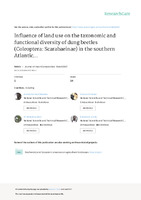Influence of land use on the taxonomic and functional diversity of dung beetles (Coleoptera: Scarabaeinae) in the southern Atlantic forest of Argentina
Date
2008-03-01Author
Gómez Cifuentes, Andrés Mauricio
Munévar, Ana Katerinne
Giménez Gómez, Victoria Carolina
Gatti, María Genoveva
Zurita, Gustavo Andrés
Metadata
Show full item recordAbstract
The degradation and replacement of native ecosystems affects both their taxonomic and functional biodiversity. However, native species may find a gradient of habitat suitability in different land uses within a region. The aim of this study was to evaluate the effect of land use on the taxonomic and functional diversity of dung beetle assemblages in the southern Atlantic forest of Argentina. Dung beetles were sampled in both the native forest (control) and different land uses (Pine and Yerba mate plantations and cattle pastures) during the 2014 summer, using pitfall traps baited with human feces and rotten meat. Samplings were taken from 20 different sites, with five replicates of each land use and the native forest (100 pitfall traps in total). A total of 1699 beetles of 27 species were captured. Canthon quinquemaculatus, Canthon conformis and Dichotomius sericeus were the most abundant species. Cattle pastures were the land use most negatively affected in their taxonomic and functional diversity, particularly large paracoprid dung beetles. Pine plantations maintained their taxonomic and functional diversity in relation to the native forest and Yerba mate plantations showed, in general, an intermediate situation. Microclimatic conditions (average temperature and humidity and maximum temperature) were correlated with functional diversity (the proportion of large paracoprid dung beetles decreased with increasing temperature) and are probably good predictors to explain the observed patterns of functional diversity of dung beetles. The development of sustainable production systems that preserve the native biodiversity requires the conservation of key components from the ecological niche of native species, especially microclimatic conditions.
Collections
The following license files are associated with this item:




